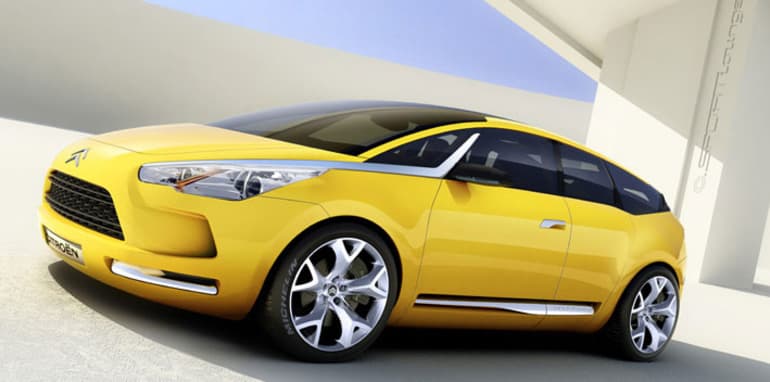

In this week’s design review we look back on a premium MPV concept from Citroën. Unveiled at the 2003 Frankfurt Motor Show, the C-Airlounge Concept was not just another design study, but a different take on the executive car segment.
The concept was designed under the guidance of Jean-Pierre Ploué, who led Citroën’s design studio from 1999-2009 before assuming his current role as Groupe PSA Head of Design. Back in the early 2000s, besides offering an array of affordable models, the French brand was also seeking alternative ways of competing with the likes of BMW and Mercedes-Benz in the premium segments.
Citroën always chose a different path for its flagships, with models like the revolutionary DS (1955), the CX (1974) and the XM (1989), leading to the controversial C6 (2005).
So what was the C-Airlounge? Well, it was the second concept car of Citroën’s new era, following the C-Airdream (2002) and preparing the world for the significantly revamped design identity of the brand. The mono-volume shape of the 4.88m long prototype, made it a premium Grand Tourer in an aerodynamic and practical MPV bodystyle, something like the Renault Avantime (more here).

The front end of the C-Airlounge might look familiar today (mostly because of the later C4 hatchback which adopted its styling cues), however it was something different back in 2003.
Most of the character lines originate from the expanding double chevrons which gradually became the core design element of all Citroën models for years to come. On the very long front overhang, the bumper was integrated with the sleek bonnet and the aggressive boomerang shaped headlights reached as high as the sloping windshield, giving it an opulent look.
The weird shape of the A-pillars made it clear this car originated from France while the dropping window line on the profile was a nod to the legendary flagship models of the past. The crease towards the end of the side windows made you look twice to understand its unusual shape, but it also brought more character and strength to the slightly bulging rear wheel arches.

The rear end was equally eccentric. The long tail-lights featured a “melting” look and abstract graphics, expanding from the roof all the way down to the rear bumper. The curved rear windscreen complemented the vertical tail and in combination with the large sunroof, shed more light into the spacious cabin.
The drag coefficiency of the concept car was an impressive 0.26cd, thanks to its overall shape and some clever details like wheel fairings, special air ducts, rims that sucked air-reducing turbulence, and the Blade vortex generators positioned on the roof, creating swirls of air and making up for the absence of a rear spoiler.
From some angles, the C-Airlounge looked like a Space Shuttle, thanks to its floating lines and the overall stance. Its futuristic design is more evident when you compare it side to side with the Citroën C8 (2002), a large MPV that looks considerably dated and uninspiring by today’s standards.

Under the bonnet, the 3.0-litre V6 engine produced 152kW and was mated to a sequential automatic gearbox with paddle-shifters behind the steering wheel, providing respectable performance figures for the highway.
The Hydractive 3 suspension system offered Normal and Sport settings with automatic height adjustment, combining comfort with good handling. The revolutionary self-levelling suspension remained the main feature of every top of the range model in Citroën’s history until just a few years ago.

Moving on to the interior, in typical concept car fashion it was full of gadgets and technologies. The modular cabin could comfortably seat four or five passengers in separate seats, with up to 650 litres of luggage space.
At the front, the dashboard featured only a few buttons and a retractable screen, with most of the functions operated from the fixed hub steering wheel (a feature that debuted on the Citroën C4 production car in 2005).

The minimal design with sci-fi elements was complemented by premium materials like leather, silk and thick wool carpet. The white upholstery served as a canvas for the passengers to create custom atmosphere using the video projectors, choosing between Pure, Convivial, Intense, Romantique and Baroque themes – a predecessor to the customisable ambient interior lighting of today’s world.
Rear passengers had access to touch-screen tablet computers stored under the armrest, allowing them to play games, watch movies, work or even surf the internet (here we should remind you that the revolutionary iPad debuted in 2010 so Citroën was way ahead of the game). All that was very impressive for 2003, however we could say that the “ribbon” shape on the doors with contrasting bright red colour was a bit over the top, even for the space age people.
So, what came next?
Two years after the debut of the C-Airlounge, Citroën launched the C-SportLounge at the 2005 Frankfurt Motor Show. This follow-up would later evolve into the DS5 executive hatchback (2011-2018) retaining most of the design but losing the fancy suicide doors.

Above: Citroën C-Sportlounge
The new flagship of Citroën, also served as the halo model for creating the design identity of the DS brand which became PSA Group’s premium marque. Although the DS5 shared the mono-volume proportions with the C-Airlounge, its styling was more aggressive and sporty, with lots of chrome and a cabin inspired by aviation.
VERDICT
Citroën nailed it with the C-Airlounge, striking a balance between quirky, cool and functional. A revolutionary production car with styling derived from the prototype, would have been a risky move. However, it could have greatly benefitted the image of the brand by uniting its promising future with some of the flair from its illustrious past.
The similarly-sized DS5 that went in production eight years after the C-Airlounge first appeared, was a good car but it came late in a world already well on the way to being conquered by premium SUVs, and while it was striking at first glance, it somehow lost a little bit of the opulence and the cool factor of the original prototype.

So that is my opinion on the C-Airlounge, however I must say that as the press photo above suggests (advertised alongside what appears to be a cast of characters from a sci-fi movie, dressed in white and holding arrows) that back in 2003, the world wasn’t quite ready for it.
[“source=caradvice”]





